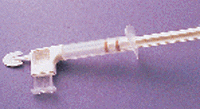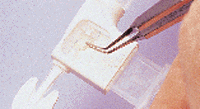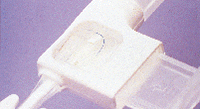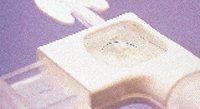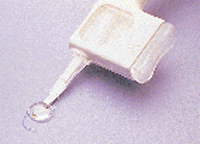IOL Injectors: the next generation arrives
The new "shooters" are designed to be safer and easier to use than earlier models.
SEATTLE — IOL makers have introduced lens-specific injector systems for their most popular models, allowing more cataract surgeons access to the ease of using shooters.
According to Andy Stapars, Allergan’s director of IOL marketing, the goal of the marketplace is to provide surgeons as many options as possible so they can achieve the best possible results.
"The earlier generation insertion devices were appropriately called shooters," he said. "Because of the properties of silicone material, one of the biggest drawbacks was that the lens would reach the point of no return and then explode into the eye."
Advances in lens materials have allowed companies to create injectors that avoid that rapid expulsion. New designs incorporate softer materials that are less likely to damage the optic, as well as enable insertion through ever-shrinking wound sizes.
Magic boxes
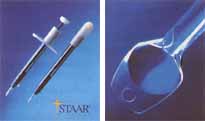 ---MicroSTAAR Injection System plunged or threaded (left). Plate-haptic IOL being expressed from the MicroSTAAR Injection System (right).
---MicroSTAAR Injection System plunged or threaded (left). Plate-haptic IOL being expressed from the MicroSTAAR Injection System (right).
The Monarch inserter from Alcon (Fort Worth, Texas) is an entirely new product designed to deliver only the AcrySof (Alcon) lens. Research and development of the AcrySof used forceps for insertion. According to Barry Caldwell, vice president of Alcon’s surgical division, the company did not want to create problems by repackaging an old delivery system.
"We wanted to get this right the first time," he said.
The lens is placed into a clear cartridge. The wings of the Monarch are folded over and the IOL is inserted with a plunger. The clear cartridge lets surgeons see the lens throughout insertion.
Because the lens is acrylic instead of silicone, Alcon designed the Monarch so it would not transfer force to the lens surface, but instead deliver it in a pristine state into the eye. Now surgeons can delegate lens loading to the scrub nurses.
"Most injectors are like magic boxes," said Richard McLaughlin, Alcon’s director of marketing for cataract surgery. "You put the lens in the chamber, close it, push it forward and you don’t see it unfold until it’s delivered into the eye. With this inserter, if it’s improperly loaded, you can abort the procedure."
While many current AcrySof users feel comfortable with forceps and are unlikely to switch, the Monarch allows Alcon to target surgeons who want to use the AcrySof without giving up the convenience of an injector.
"This injector allows us to enter a segment of the market that are used to shooters," Mr. Caldwell said. "It allows us to move the AcrySof into a segment of the market that was not comfortable giving up their inserter technology."
Additional insertion device for AcrySof
 ---The Passport system is a single-handed, syringe-type, direct delivery disposable system. As the Passport is engaged, the IOL is delivered into the capsulorrhexis and symmetrically unfolds.
---The Passport system is a single-handed, syringe-type, direct delivery disposable system. As the Passport is engaged, the IOL is delivered into the capsulorrhexis and symmetrically unfolds.
Robert Osher, MD, developed an IOL insertion device in conjunction with Duckworth and Kent (St. Louis) for implantation of the Alcon AcrySof lens. The insertion system consists of three devices: two rounded adjacent titanium pegs and a short stump on a platform and insertion forceps. First, Dr. Osher warms the AcrySof lens with 100°F balanced salt solution. "This converts the AcrySof from a stiff lens into a very flexible, easy-to-use lens," Dr. Osher said. "This technique is very easy."
The IOL is placed on a drop of viscoelastic material on the stump. Insertion forceps come down upon the lens and grasp it off the stump The special footplates on the folding forceps cause the lens to fold in the proper direction. Dr. Osher said, "It’s automatic, there’s no flicking, and there's no reverse folding." Dr. Osher added that the blades of the inserter are offset with respect to the shaft so when the surgeon supinates his or her fingers, it drops the haptics right into the capsular bag.
The insertion system also can be used with Allergan's multifocal lens or Bausch & Lomb Surgical's Hydrogel lens.
Dr. Osher created his own insertion method because he wanted to feel more in control of the process. "I like to fold the lens myself, so my fingers are in control of the insertion, rather than depending upon an injection device," he said.
Silver and gold
 ---The Unfolder Gold, cartridge, SofTip with sheath, and SI55. The Unfolder Gold system permits IOL implantation through the same incision used for phaco.
---The Unfolder Gold, cartridge, SofTip with sheath, and SI55. The Unfolder Gold system permits IOL implantation through the same incision used for phaco.
Allergan Surgical Products (Irvine, Calif.) introduced its Unfolder Implantation System to handle its AMO Phacoflex II lens. Two models, the Silver Series and the Gold Series, accommodate the company’s 5.5-mm optic lens and 6-mm optic lens, Mr. Stapars said.
Both systems allow a surgeon to create an incision with a final size of 2.65 mm. The Unfolder has a titanium handpiece with a disposable cartridge to provide sterile delivery of the lens into the eye. A planned upgrade schedule for release later this year is designed to load the lens directly from its primary package.
The cartridge closes on the lens and properly orients the leading haptic down the barrel, Mr. Stapars said. The trailing haptic comes out of the back half of the cartridge, which allows the silicone tip to slide in, engage the optic, and then advance it down the narrow 2.1-mm tip of The Unfolder.
"A lot of people were claiming incision sizes as low as 2 mm," he said. "Realistically, those numbers are not the post-insertion size. Everyone can start out with a small incision size, but if they have to enlarge or manipulate while they are inserting their lens, ultimately it’s the final wound size that matters."
The movement behind Phacoflex II lenses was to combine its material, SLM2, with an injector that allowed for the smallest incision size post-insertion in surgery, he said.
"It allows for as slow and controlled a release as the surgeon desires," Mr. Stapars said. "You can have 95% of the lens delivered and you still have the ability to stop the procedure and adjust anything that is necessary."
A physician’s use of The Unfolder
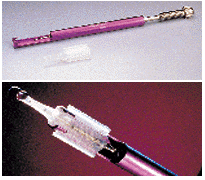 ---The Monarch IOL Delivery System (top) reusable titanium handpiece and unique single piece disposable cartridge that allows visibility of the lens throughout the delivery process. The AcrySof IOL (bottom) being delivered using the Monarch IOL Delivery System.
---The Monarch IOL Delivery System (top) reusable titanium handpiece and unique single piece disposable cartridge that allows visibility of the lens throughout the delivery process. The AcrySof IOL (bottom) being delivered using the Monarch IOL Delivery System.
John Hunkeler, MD, a cataract and lens implant surgeon in Kansas City, Mo., said, "I routinely use The Unfolder with both 6-mm silicone multifocal lens implants, 6-mm monofocal lens implants and also a newer 5.5-mm silicone monofocal lens implant, also available from Allergan. I prefer insertion devices because of their consistency, dependability and ease of loading. The system can be loaded by a technician during the cataract procedure in time for use during lens implantation. Also, the disposable cartridge and soft tip facilitate the implantation with disposable components that present a new, smooth surface, minimizing the likelihood of damage to the implant. Although the metal handpiece is reusable, the disposable components are prepared so that no damage occurs to the implant."
The implant is loaded into the disposable cartridge with appropriate viscoelastic in place. The cartridge wings are closed, and the cartridge is inserted into the handpiece. The soft tip is advanced in the handpiece to engage the lens implant in the cartridge. The tapered cartridge tip is inserted into the eye, and the implant is advanced into the capsular bag. The soft tip is retracted and, while the cartridge remains inside the eye, the soft tip is used to advance the trailing haptic and place it also within the capsular bag. The system is removed, and the viscoelastic is evacuated from the anterior chamber through the 3-mm clear cornea cataract incision. With the second-generation silicone, the smallest incision opening can be used for cataract and lens implant surgery.
Three-piece lens implants like the Allergan SI-40 or multifocal SA-40 center very well, Dr. Hunkeler said. "With The Unfolder delivery system, the haptics are undamaged during the insertion. As a result, centration is highly unlikely. With my personal previous experience with inserters, plate haptic lens implants were observed to decenter on a regular basis in the short axis of the implant due to the fact that the implant does not adequately fill the capsular bag and decentration should be expected."
Dr. Hunkeler prefers The Unfolder because of his preference toward three-piece IOLs. "The Unfolder allows a more controlled release of the implant, compared with other systems. With other systems, the lens implant tends to jump out of the cartridge and risk damage to the intraocular anatomy."
Blossoming lens
 ---The Osher Insertion System (manufactured by Duckworth & Kent, St. Louis, U.S.A.) consists of two rounded adjacent titanium pegs and a short stump on a platform and insertion forceps.
---The Osher Insertion System (manufactured by Duckworth & Kent, St. Louis, U.S.A.) consists of two rounded adjacent titanium pegs and a short stump on a platform and insertion forceps.
Bausch & Lomb (Claremont, Calif.) introduced its Mport inserter for the LI61U lens, the company’s three-piece silicone IOL, said Marianne Whitby, senior product manager. Bausch & Lomb introduced the Mport system to North America, Latin America and the Asian-Pacific countries.
Like other inserters, the Mport uses a single-handed syringe mechanism.
"The plunger is a very easy way to insert the lens into the eye," Ms. Whitby said. "Since you’re not using the screw type mechanism, you’re not torquing the instrument inside the eye or having to manipulate the lens.
Unlike other inserters, the lens is squeezed into an "M" shape, like the pleats in an accordion. When the lens is extruded to the tip, the lens unfolds on a flat plane. At the tip of the inserter, a slit allows the lens to flatten out. The company is marketing the action as a "blossom" motion.
"Because the lens is not folded like a taco, it does not unfold with a haptic sweep," Ms. Whitby said. "You have a nice, smooth unfolding on a flat plane into the eye so it’s very atraumatic."
The company also has upgraded the Passport inserter, now called Passport 2, for the company’s C11UV plate lens. The Passport 2 and Mport were both in development when Bausch & Lomb purchased Chiron. The company will continue to market both products.
The Passport
Robert Kellan, MD, a cataract/IOL surgeon in Methuen, Mass., incorporates Bausch & Lomb Surgical's IOLs and the Passport inserter.
The Passport system is a single-handed, syringe-type, direct delivery disposable system. The Passport system is not preloaded with an IOL. An assistant to Dr. Kellan is responsible for placing the lens, a C11UB plate haptic silicone lens, into the loading platform device. According to Dr. Kellan, the tip of the device is inserted above and central to the capsulorrhexis. As the Passport is engaged, the IOL is delivered into the capsulorrhexis and symmetrically unfolds. Once the lens is in place in the capsular bag, the insertion device is released and retracted from the eye. It is common for the superior haptic to not be in the capsular bag. Dr. Kellan uses a nucleus rotator and inserts the superior haptic into the bag and then rotates the lens.
Dr. Kellan prefers the Passport system for numerous reasons. "I like the Passport tip because the shape is wound friendly," Dr. Kellan said. "It is very similar to the phacoemulsification tip that the wound has been accepting throughout the operation, unlike forceps." Other reasons he uses the Passport include not having to enlarge the phacoemulsification incision. Increasing the size of the incision puts the patient at risk for a greater degree of astigmatism. Additionally, the Passport is designed to hold the lens throughout the delivery into the eye.
"You can release it when you wish. You are in control throughout the implantation of the lens," Dr. Kellan said.
The IOL is loaded in a sterile field and remains there until it is implanted in the eye. According to Dr. Kellan, this is most important because bacteria, such as Staphylococcus epidermis or Staphylococcus aureus — two culprits for endophthalmitis onset — live in the cilia. "The bacteria are present in the cilia and get into the conjunctival fluids," Dr. Kellan said. "The main treatment for endophthalmitis is prevention, so you want to minimize anything entering the anterior chamber from being dragged into the conjunctival fluid." Dr. Kellan noted that there is no way of preventing the transportation of the bacteria into the anterior chamber when forceps are used.
Foam nudging
Like the companies making aphakic lenses, STAAR Surgical Co. (Monrovia, Calif.) has designed an injector that eases lens loading. The Microstar System allows the surgeon to place its plate haptic lens into a loading area. The lid, a transverse hinge, snaps down over the lens. The cartridge is placed over the entire hinge and the plunger advances the lens.
STAAR Surgical has replaced its titanium injector with smaller, plastic, re-useable injection cartridges that go down to 2.1-mm incisions, as well as provide more user-friendly lens loading.
The goal is to create a system that will load its lenses into increasingly smaller incisions of 2 mm or less, said Thomas Chambers, assistant vice president of corporate operations. The flexible, delicate material is injected with a foam-tip plunger mechanism made from material similar to that of a Weck-cel sponge.
Before, surgeons implanting the company’s phakic IOL needed to rig sponges and insert the lens manually. The system is now integrated.
"The tip nudges the lens up the front and out," Mr. Chambers said. "The crystalline lens is still intact, so we didn’t want any kind of plungers or any kind of barbed tipped plungers entering the anterior chamber. The foam nudges the lens out into the anterior chamber where it opens up, but the tip is still in the cartridge so it’s safe."
STAAR Shooter
"The STAAR Shooter is the only one I use that fits through a 2.65-mm incision," said Paul Koch, MD, a cataract/IOL specialist in private practice in Warwick, R.I. "I inject the STAAR three-piece 6.5-mm optic lens through a 2.6-mm incision." STAAR also has one that fits through a 3.2-mm incision.
The lens is prefolded and inserted in the cartridge. Through the 2.6-mm incision, the cartridge is placed bevel down. Dr. Koch advances the cartridge only approximately halfway across the eye. "That gives the lens enough room to pop out without being pushed out too far into the capsular bag," Dr. Koch said. "This way, it will unfold gently into the middle of the eye."
Dr. Koch uses a screw injector. After inserting the cartridge into the eye, the lens is slowly screwed in place. "I screw the first haptic so that it pops into the capsular bag, making sure it goes into the bag in the correct orientation," Dr. Koch said. "I rotate the Shooter clockwise, so the optic goes into the eye properly, and then I rotate back counterclockwise to be sure the optic falls into the bag."
As Dr. Koch inserts the optic in the capsular bag, the cartridge is withdrawn a little bit so there is no force against the furthermost side of the capsular bag. "Once the optic pops out, in most instances I am able to keep pushing the Shooter in until the tip engages the haptic optic junction," Dr. Koch said. "Then, I can direct the haptic downward and push the second haptic into the capsular bag."
When using high-powered lenses with the Shooter, there is a chance of a device complication, according to Dr. Koch. "With very high-powered lenses, if I don't have the tip far enough in the eye, then the bent-over optic comes through the cartridge," Dr. Koch said. "If there is a lot of space between the injector tip and the incision, the side wall of the injector may split."
In this instance, Dr. Koch recommends the surgeon push the entire cartridge into the eye the remainder of the way. The incision will continue to hold the optic until it gets in the eye, and then it will slide out through the slit of the cartridge, inside the eye.
Dr. Koch said the frequency of a Shooter inserter splitting is dependent on how many high-powered lenses are used. "Out of the high-powered lenses that we use," Dr. Koch said, "there is probably a 1 in 20 chance of a cartridge splitting." By pushing the cartridge further into the eye, splitting of the cartridge can be avoided because the incision halts the force from the unfolding action of the lens, he added.
| Mport Injector | ||
|
|
| |
|
| ||
|
| ||
For Your Information:
- Andy Stapars can be reached at Allergan Surgical Products, 2525 Dupont Drive, P.O. Box 19534, Irvine, CA 92623-9534 U.S.A.; +(1) 714-246-2477; fax: +(1) 714-246-2440. Mr. Stapars is U.S. director of IOL marketing at Allergan Surgical Products.
- Barry Caldwell and Richard McLaughlin can be reached at Alcon Laboratories Inc., 6201 South Freeway, Fort Worth, TX 76134-2099 U.S.A.; +(1) 817-551-8539; fax: +(1) 817-551-4030. Mr. Caldwell is vice president at Alcon Laboratories Inc. Mr. McLaughlin is director of marketing at Alcon Laboratories Inc.
- Marianne Whitby can be reached at Bausch & Lomb Surgical, 3365 Tree Court Industrial Blvd., St. Louis, MO 63122 U.S.A.; +(1) 314-225-5051; fax: +(1) 314-861-1960. Ms. Whitby is senior product manager of implants at Bausch & Lomb Surgical.
- Thomas Chambers can be reached at STAAR Surgical Co., 1911 Walker Ave., Monrovia, CA 91016 U.S.A.; +(1) 626-303-7902; fax: +(1) 626-359-8402. Mr. Chambers is assistant vice president of corporate operations at STAAR Surgical Co.
- Robert Kellan, MD, can be reached at 60 East St., Ste. 1100, Methuen, MA 01844 U.S.A.; +(1) 978-682-8661; fax: +(1) 978- 685-3591. Dr. Kellan has no direct financial interest in any of the products mentioned in this article, nor is he a paid consultant for any companies mentioned.
- Paul Koch, MD, can be reached at 566 Tollgate Road, Warwick, RI U.S.A.; +(1) 401-738-4800; fax: +(1) 401-738-8153. Dr. Koch has no direct financial interest in any of the products mentioned in this article, nor is he a paid consultant for any companies mentioned.
- John Kearney, MD, can be reached at 135 County Highway 128, Johnstown, NY 12095 U.S.A.; +(1) 518-773-2020; fax: +(1) 518-762-2022. Dr. Kearney has no direct financial interest in any of the products mentioned in this article, nor is he a paid consultant for any companies mentioned.
- John Hunkeler, MD, can be reached at 4321 Washington, Ste. 6000, Kansas City, MO 64111 U.S.A.; +(1) 816-931-4733; fax: +(1) 816-931-9498. Dr. Hunkeler did not disclose whether he has a direct financial interest in any of the products mentioned in this article, or if he is a paid consultant for any companies mentioned.
- Robert H. Osher, MD, can be reached at 10494 Montgomery Road, Cincinnati, OH 45242 U.S.A.; +(1) 513-984-5133; fax: +(1) 513-984-4240. Dr. Osher did not disclose whether he has a direct financial interest in any of the products mentioned in this article, or if he is a paid consultant for any companies mentioned.
- The Passport II is available from Bausch & Lomb Surgical, 555 W. Arrow Hwy, Claremont, CA 91711 U.S.A.; 800-423-1871; fax: +(1) 909-399-1525.
- The Mport is available from Bausch & Lomb Surgical, 555 W. Arrow Hwy, Claremont, CA 91711 U.S.A.; 800- 423-1871; fax: +(1) 909-399-1525.
- The Microstar System and The Shooter are available from STAAR Surgical Co., 1911 Walker Ave., Monrovia, CA 91016 U.S.A.; +(1) 818-303-7902; fax: +(1) 818-358-9187.
- The Unfolder is available from Allergan, 252 Dupont Drive, Irvine, CA 92612 U.S.A.; +(1) 714-246-4500; fax: +(1) 714-246-6976.
- Duckworth & Kent is located at 10805 Sunset Office Drive, Ste. 207, St. Louis, MO 63127 U.S.A.; +(1) 314-822-5400; fax: +(1) 314-822-5426; e-mail: info@duckworth-and-kent.com; Web site: www.duckworth-and-kent.com.
- The AcrySof lens is available from Alcon, 6201 South Freeway, Fort Worth, TX 76134 U.S.A.; +(1) 871-551-4301; fax: +(1) 871-551-8968.
- The Monarch IOL Delivery System is available from Alcon, 6201 South Freeway, Fort Worth, TX 76134 U.S.A.; +(1) 871-551-4301; fax: +(1) 871-551-8968.

